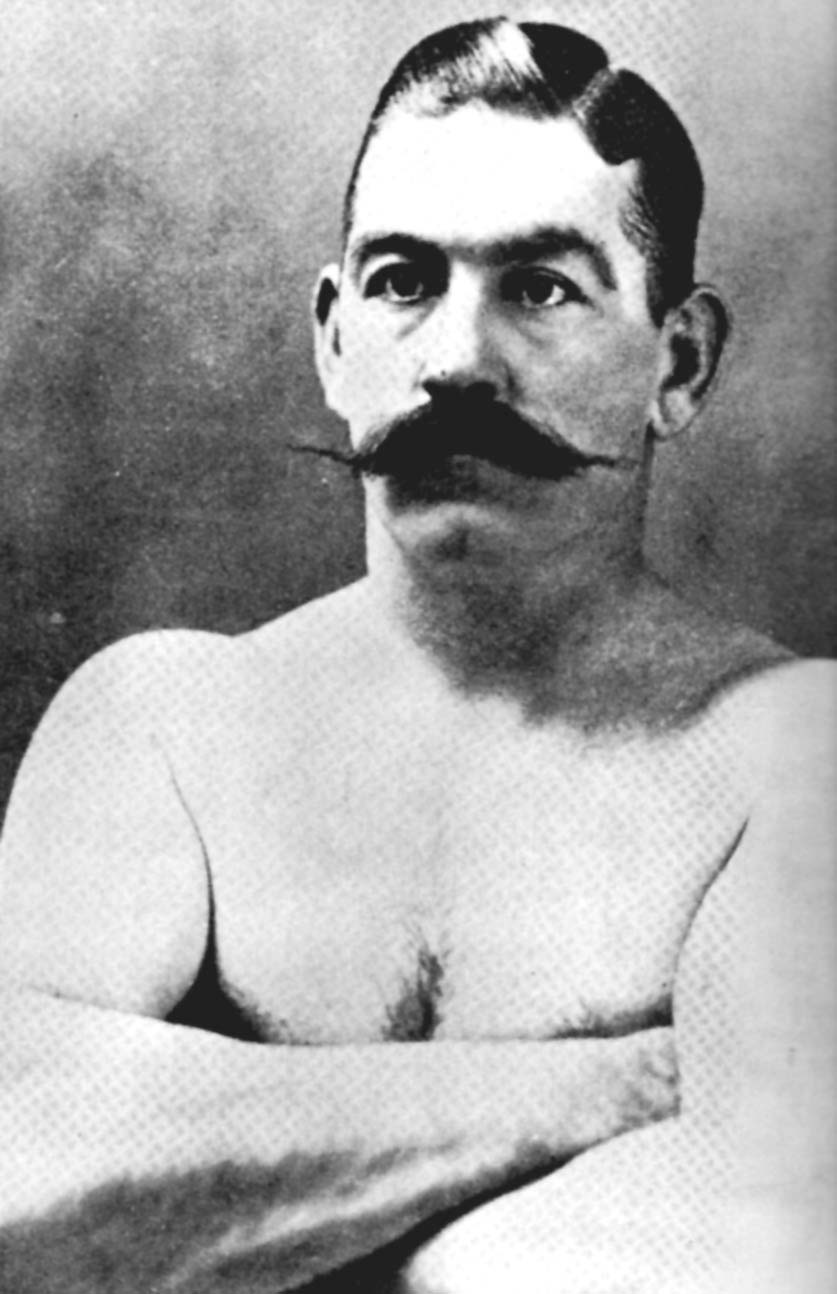
JOHN L. SULLIVAN ... "I CAN LICK ANY MAN IN
THE HOUSE"
By Tracy Callis
 |
|
|
Shirtless, adorned in
knee-breeches and stockings, wearing fighting boots (shoes with spikes), the
great John L. fought using either bare-knuckles, skin-tight gloves, or padded
gloves. He battled under both – the London Prize Ring Rules and the Marquis of
Queensberry Rules. McCallum (1974 p 3) calls him “the true link between the
bare-knuckle and glove eras”. John could also take a good
punch. In his prime, he quickly disposed of power hitters and, because of his
endurance, was able to catch and defeat his greatest problem as a fighter – the
“hit-and-run” tactician. But, over the years, his drinking and riotous living
habits did him in. He even drank and smoked cigars during training. |
|
|
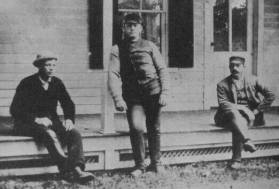 |
|
He fought in a day when a man
received credit for a knockout only if he scored a knockout. There were no
technical knockouts. If a fight was stopped by a referee because of an injury
such as a broken arm or by the police to prevent a brutal beating - there was no
knockout. If an opponent quit fighting or ran from the ring - there was no
knockout. The verdict was a “win”. There were many “No Decision”
bouts on his record and, doubtless, if the details of these matches were known,
he would have many more knockouts. Durant (1976 p 24) writes that Sullivan is
estimated to have knocked out some 200 men during his career while fighting all
types of men – lumberjacks, blacksmiths, local strong boys, and professional
fighters. Further, during the early years,
records were often in error (for various reasons). Even topnotch fighters were
apt to let many victories over minor opponents slip away unrecorded. There is no question that John
L. could hit. Langley (1973 pp 27 29) writes “As a knockout specialist John’s
record remains unbeaten. No other fighter in history has left such a trail of
broken and aching jaws behind him”. Tim Scannell, 200-pound
competitor, was lifted up and out of the ring by a Sullivan punch. Charlie
Mitchell and John Donaldson were also knocked out of the ring. He knocked many men “cold” and
battered numerous others into helpless submission. John Flood, Paddy Ryan, Jake
Kilrain, John Laflin, and Frank Herald were among those who had to be carried
from the ring. He broke jaws and bashed in
faces with abandon. Johnny “Cocky” Woods, Kilrain, Scannell, Laflin, and Ryan
were numbered among those who carried distorted features in the years following
their pounding by the “Great John L”. Paddy Ryan said “When Sullivan hit me, I thought a telegraph pole had been shoved against me endways” (see Durant and Bettman 1952 p 79; Durant 1976 p 22). |
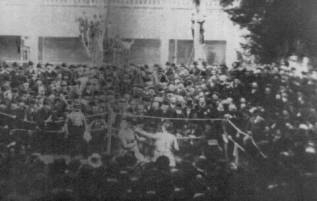 |
Professor Mike Donovan commented on Sullivan’s style “It wasn’t boxing. It was like being hit by a runaway horse”. The Professor called John L. the strongest man he ever fought and add, “He used his right as a blacksmith would use a sledge hammer …” (see Durant and Rice 1946 and McCallum 1974 p 10). |
|
Charlie Harvey, old time manager,
described Sullivan as a “rushing, tearing-in, two-fisted fighter with a power
punch” and called him “… big, fast, and courageous” (see Fleischer 1972 p
207). Diamond (1954 p 10) writes about
Sullivan – “He was quick on his feet – as quick as any modern heavyweight. And
what a punch he had! A knockout in each hand! He was not a scientific boxer but
a slugger, depending mainly on a vicious right swing to the jaw”. Durant and Rice (1946) state “He
was superbly fast with his hands and he moved always forward, growling as he
advanced”. Grombach (1977 p 43) describes Sullivan in this way “According to the writers of his time, he was a great burly, slugging fighter with bull-like tactics, mighty fists, and little science. He was good-natured, generous, conceited, blustering, and extremely popular”. |
|
Durant and Bettman (1952 p
79) state that “…he was more than merely strong. He was amazingly fast for
a big man and had a knock-em-dead punch in either hand. Ring science was
not for John L. He never bothered much with defense. He brushed aside
blows and kept moving forward, always punching. His was a hurricane
attack”. |
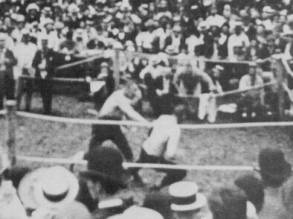 |
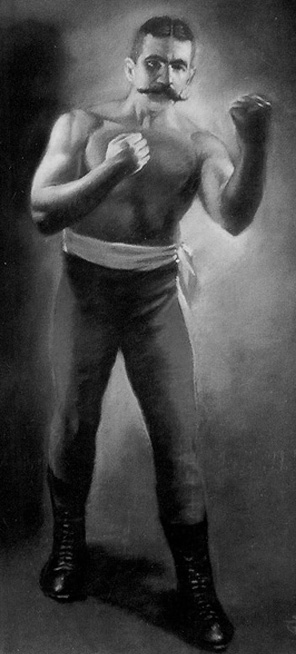 |
Lardner (1972 p 43) writes that
Sullivan was a bully, a boozer, and a braggart and later adds that he looked
like a conqueror with his florid face, black brow, black hair, mustache, and
aggressive fighter’s jaw. Burrill (1974 p 181) says he was “notorious for
drinking and tavern brawls”. Tom Langley (1973 p 31) says that “Sullivan
implicitly believed in his invincibility and wasted no time in passing on this
information to the world”. Billy Roche, famous referee,
rated Sullivan as the greatest of all heavyweights and said that John L. had the
best “One-Two”punch that he (Roche) ever saw (see McCallum 1974 p 4). Gilbert Odd, Boxing Historian,
once wrote that John L. in most of his early years only had to hit a man one
time. If he did not knock the man out of the fight, he knocked the fight out of
the man. Jim Jeffries called Sullivan the
greatest fighter in ring history (see Fullerton 1929 p VIII). Cooper (1978 p
103) calls “… John L., the Champion of Champions to everybody who saw him fight
…”. Grombach (1977 p 46) writes: “…if the strength, speed, hitting power, fighting instinct, and ring ferocity of Sullivan had been developed in the school of modern boxing, and were he around today, he would be a dangerous challenger to any champion”. |
Burrill, B. 1974. Who’s Who
In Boxing. New Rochelle, NY: Arlington House
Cooper, H. 1978. The Great
Heavyweights. Secaucus, New Jersey: Chartwell Books, Inc.
Diamond, W. 1954. Kings of
the Ring. London: The World’s Work (1913) Ltd.
Durant, J. and Bettman, O. 1952.
Pictorial History of American Sports. Cranbury, New Jersey: A.S. Barnes
and Co.
Durant, J. and Rice, E. 1946.
Come Out Fighting. Cincinnati: Zebra Picture Books.
Durant, J. 1976. The
Heavyweight Champions. New York: Hastings House Pub.
Fleischer, N. 1972. Jack
Dempsey. New Rochelle, NY: Arlington House.
Fullerton, H. 1929.
Two-Fisted Jeff. Chicago: Consolidated Book Publishers, Inc.
Grombach, J. 1977. The Saga
of Sock. London : Thomas Yoseloff Ltd.; Cranbury, New Jersey: A.S. Barnes
and Company, Inc.
Langley, T. 1973. The Life of
John L. Sullivan. Leicester, England: Vance Harvey Publishing.
Lardner, R. 1972. The
Legendary Champions. New York: American Heritage Press.
McCallum, J. 1974. The World
Heavyweight Boxing Championship. Radnor, Pa.: Chilton Book Company
Return to Top
John L. Sullivan Record
Tracy Callis
All-Time Rankings
Callis Archive